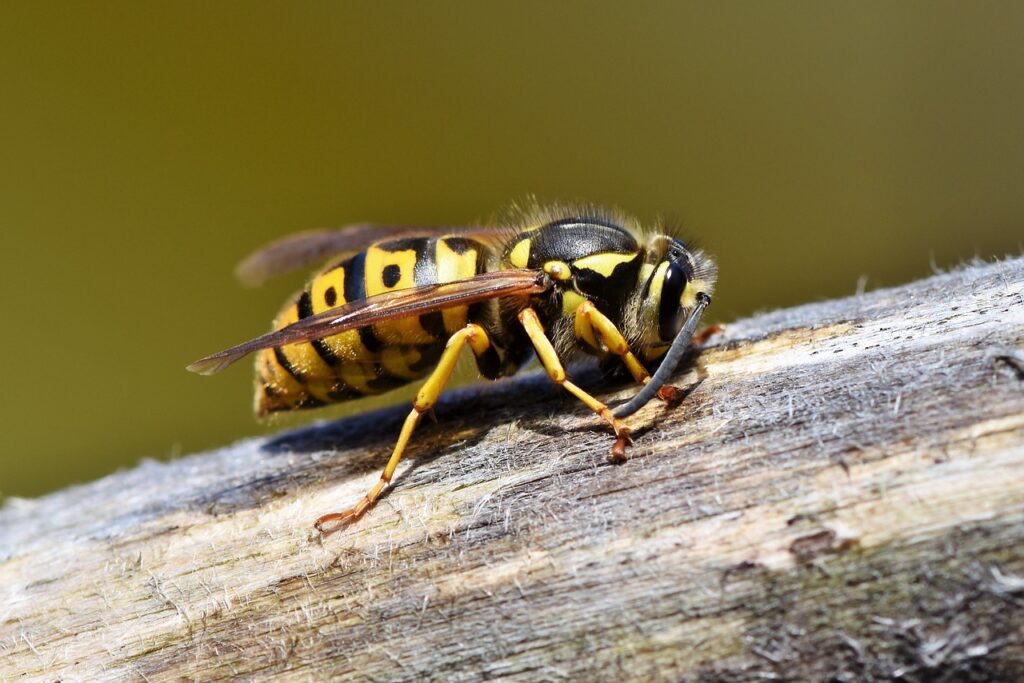Moths and wasps are insects that can inspire both fear and awe in many people. They each are a part of different but massive insect families that include other insects closely related to them. Moths strike most people as beautiful or whimsical, or even cute. Wasps, on the other hand, are often rumored to be aggressive. Many species of wasp have bright colors meant to warn of their potentially painful sting. While both animals are insects, they have several clear differences between them.
5 Differences Between the Moth and Wasp
1. Order. Moths and wasps are both a part of the Insecta Class but diverge in their Order. Lepidoptera contains butterflies and moths, while Hymenoptera includes wasps, bees, and ants.
2. Color and Pattern. Moths come in a variety of patterns and colors. From the deep green of the Luna moth to the intricate red patterns of the Atlas moth, these insects are painted in several different ways. Wasps, while some species have variations, are known for being striped in black and bright yellow.
3. Diet. Wasps are carnivorous while in the larval stage, but they will only feed on sugars as adults. Moths consume nectar but are often blamed for chewing holes in clothing.
4. Social Behavior. Moths are solitary creatures that prefer to hide to avoid predators. Many wasps, however, are highly social animals.
5. Danger. While consuming a moth may make a human sick, these insects generally do not have a bite or sting to protect themselves from predators. Wasps can both sting and bite, although they do not often bite humans.
Different Orders
Lepidoptera is Greek for “scale” and “wing”, and was given to the order containing moths and butterflies due to their wings being covered in very tiny scales. These scales help butterflies and moths to fly. Hymenoptera includes sawflies as well as bees, ants, and wasps. “Hymen” comes from the Greek word for “membrane,” and “ptera” from the Greek word meaning “wing.” While the moth and wasp are both insects and have all the qualities of insects, they differ greatly in appearance, shape, and behavior.
Different Colors and Patterns
While wasps are known for being bright yellow and black, they come in many other colors and patterns.
Bright colors in the animal kingdom are often meant to warn predators that their potential prey is toxic or venomous. The Blue Mud Wasp is a bright and metallic blue, while the Cuckoo wasp can sport a rainbow of colors.

Moths tend to be much duller in color and more often utilize camouflage. The Peppered Moth is a good example of this phenomenon.

Different Diets
While moths are known for their ability to destroy clothing, their larvae consume the threads of clothing left in the closet. Adult moths and wasps both consume liquid sugars in the form of nectar. Wasps will also consume honeydew from aphids. Wasp larvae will be fed bits of insects that an adult wasp hunts down and chews up. A Tarantula Hawk, a type of wasp, will hunt down the desert-dwelling spiders. The female wasp will sting a tarantula and lay her egg in the body of the spider. When the larvae hatch, it feasts on the tarantula until it has become an adult.
Social vs. Solitary Creatures
While most wasps are loners, much like moths, the wasps that are social animals have interesting and complex hierarchies. These hierarchies are very similar to that of bees and ants. A queen wasp and the colony is made up of her female offspring, none of which lay eggs or reproduce themselves. They will build and repair the nest, gather food, and take care of the larvae. Some social wasps even can recognize each other’s unique facial features- and spot outsiders.
The Danger They Pose
Moths are not as well known as wasps for being dangerous, with one exception. Moths are not aggressive, however, and cannot be provoked into an attack. They do not have a stinger, and most adult moths have no mouth or teeth that they can use to bite a person. Wasps can often be provoked if their nest is threatened. They have mouthparts capable of delivering a bite, although this is uncommon. More often, a wasp will sting. This can pose a danger to someone allergic to venom or someone trapped in a swarm. Despite this, wasps generally leave humans alone if they are also left alone.
Questions and Answers
Question: Do wasps prey on moths?
Answer: Yes. Paper wasps, in particular, will hunt moth larvae, although typically only wasp larvae are carnivorous and will eat insect parts.
Question: Can the moth and wasp produce a hybrid?
Answer: No. They are too different biologically as there are several species, each in different Orders.
Question: Do moths and wasps eat the same things?
Answer: Yes. Adult moths and wasps will both feed on sugars such as nectar.
Question: Are moths and wasps both insects?
Answer: Yes, both are part of the Class Insecta.
Question: Do moths or wasps make good pets?
Answer: No. More popular pet bugs would be Madagascar Hissing Cockroaches, Mantises, and African giant millipedes. Neither of these insects is easily domesticated or cared for. Both would be a risk of developing into a pest problem.
Question: Do moths and wasps get along?
Answer: No. Despite living alongside each other in the same general habitats and locations, they are not symbiotic. Wasps will often prey on moth larvae.
Question: Are moths and wasps dangerous?
Answer: No. Although consuming a moth can lead to illness for a human being, moths are not typically known for being dangerous. Additionally, despite wasps being known to sting, they often do not pose a great danger to humans who leave them alone.

